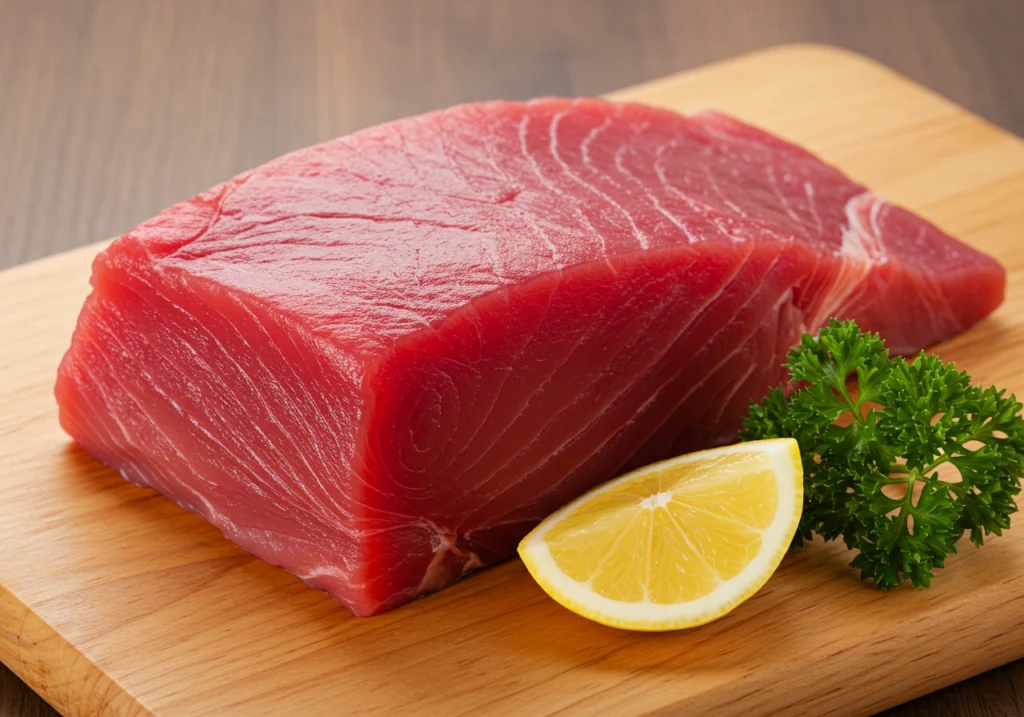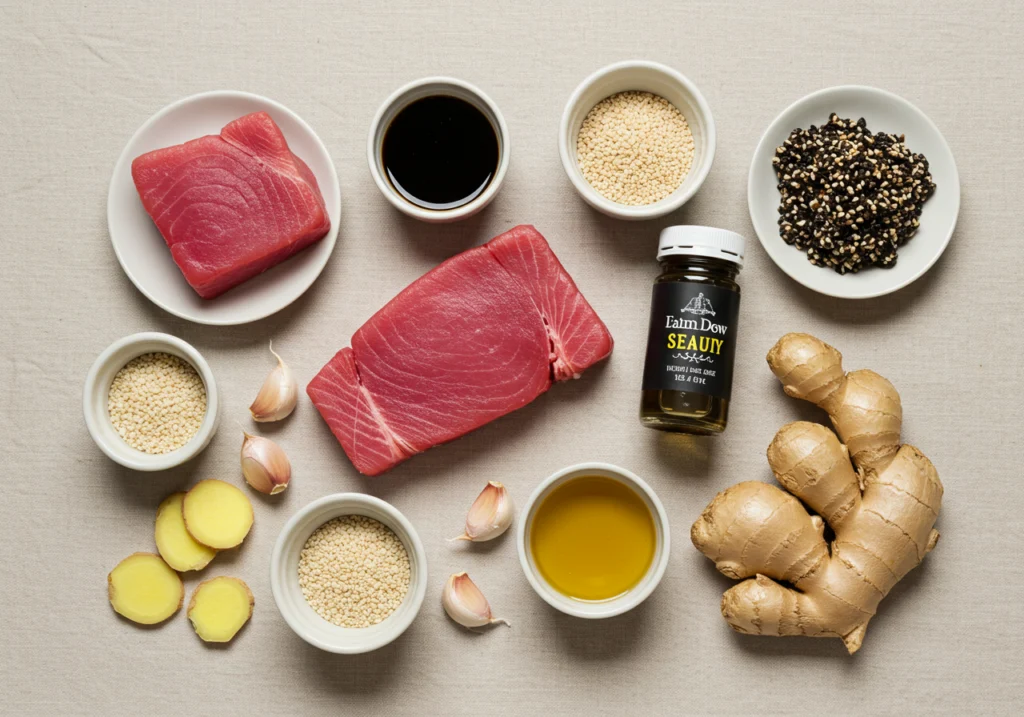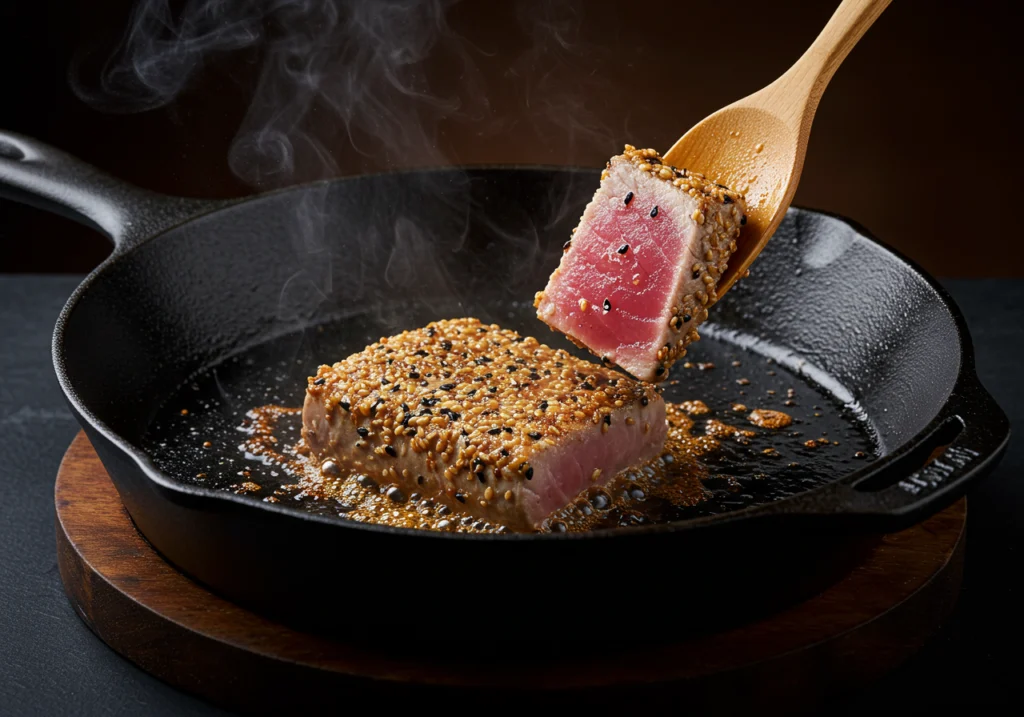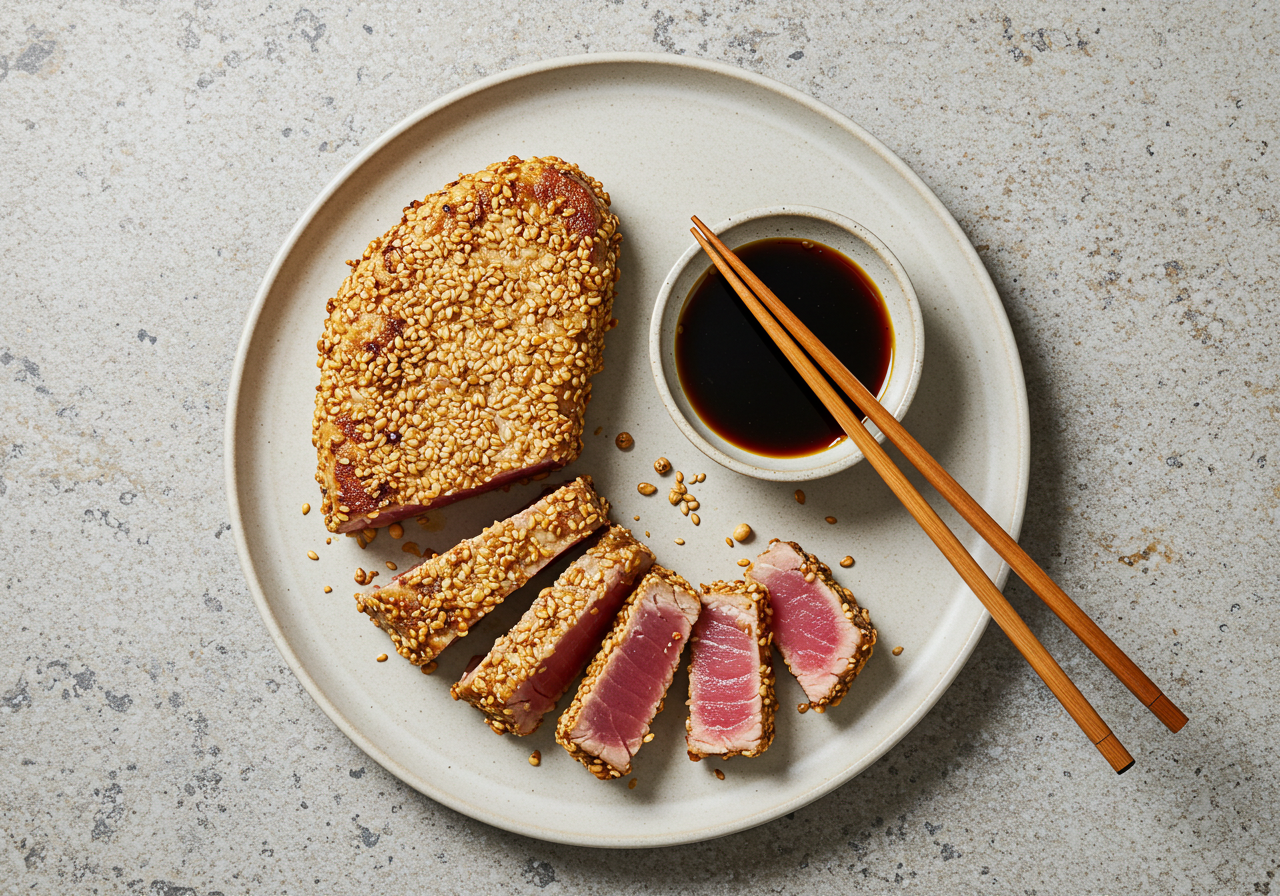Introduction
Ahi tuna is a versatile and nutrient-rich fish that has become a staple in many cuisines, especially in Asian and Hawaiian dishes. Whether you’re a sushi lover, a fan of seared tuna, or someone who enjoys fresh seafood, ahi tuna offers a delicate yet meaty flavor that makes it a favorite among food enthusiasts.
Cooking ahi tuna can be intimidating at first, but once you learn the basics of selecting, storing, and preparing it, you’ll discover that it’s one of the easiest and most rewarding seafood dishes to make. This article provides a complete guide to making the perfect ahi tuna recipe, from understanding its culinary importance to mastering different cooking techniques.
By the end of this guide, you’ll have the knowledge to prepare a restaurant-quality ahi tuna dish in your own kitchen. Whether you want to enjoy it as a main course, add it to a salad, or serve it as a show-stopping appetizer, you’ll be equipped with all the tips and tricks to make the most out of your ahi tuna recipe.
Part 1: Understanding Ahi Tuna
What is Ahi Tuna?
Ahi tuna refers to two species of tuna: yellowfin (Thunnus albacares) and bigeye tuna (Thunnus obesus). These fish are widely sought after for their rich flavor and firm texture, making them ideal for both raw and cooked preparations.
The name “ahi” originates from the Hawaiian language and is commonly used to describe high-quality tuna, often used in sushi and poke bowls. Unlike other types of tuna, ahi tuna is known for its deep red or pink flesh, which is a sign of freshness and high protein content.
Nutritional Benefits of Ahi Tuna
Eating ahi tuna isn’t just about enjoying its delicious taste—it also comes with several health benefits:
- High in Protein – A 3-ounce serving of ahi tuna contains around 25 grams of protein, making it an excellent choice for muscle building and repair.
- Rich in Omega-3 Fatty Acids – These essential fats support heart health, reduce inflammation, and improve brain function.
- Low in Calories and Carbs – Perfect for those following a low-carb or keto diet.
- Packed with Essential Vitamins and Minerals – Ahi tuna is an excellent source of Vitamin B12, iron, magnesium, and potassium.
With such a strong nutritional profile, it’s no surprise that ahi tuna is a favorite among health-conscious food lovers.
Why Ahi Tuna is Popular in Global Cuisine
Ahi tuna is widely used in different cuisines across the world, and each culture has its own unique way of preparing it:
- Japanese Cuisine: Used in sushi, sashimi, and tataki.
- Hawaiian Cuisine: A key ingredient in poke bowls.
- Mediterranean Cuisine: Often grilled and served with fresh vegetables and lemon.
- American Cuisine: Frequently found in seared tuna steaks, tacos, and salads.
Its ability to be eaten raw or cooked makes it one of the most adaptable seafood choices in the culinary world.
How to Identify High-Quality Ahi Tuna
Choosing the best ahi tuna is essential for creating a flavorful and safe dish. Here’s what to look for when buying fresh ahi tuna:
- Color – Look for a deep red or bright pink color. Avoid fish that looks brown or discolored.
- Texture – The flesh should be firm, smooth, and slightly translucent.
- Smell – Fresh ahi tuna should have a mild, ocean-like aroma. If it smells overly fishy, it’s not fresh.
- Source – Whenever possible, buy sushi-grade or wild-caught ahi tuna for the best quality.
For frozen ahi tuna, ensure it’s vacuum-sealed and free from freezer burn.
How to Store Ahi Tuna Properly
Proper storage is crucial to maintaining the freshness and taste of ahi tuna. Follow these steps:
- Refrigeration: Store fresh ahi tuna in the coldest part of your refrigerator and consume it within 1-2 days.
- Freezing: If you’re not planning to use it right away, wrap the fish tightly in plastic wrap and store it in an airtight container in the freezer for up to 3 months.
- Thawing: To thaw frozen ahi tuna, place it in the refrigerator overnight or submerge it in cold water for about 30 minutes before cooking.
Part 2: Selecting and Preparing Ahi Tuna
When it comes to preparing the perfect ahi tuna recipe, selecting high-quality fish is half the battle. The fresher the tuna, the better the flavor and texture. Since ahi tuna is often eaten raw or lightly seared, it’s essential to choose the best cuts and store them properly to maintain their freshness and safety.
How to Choose Fresh Ahi Tuna
Finding the freshest ahi tuna is crucial to achieving the best taste and texture. Whether you’re purchasing from a local fish market or a grocery store, here’s what you need to know to select premium-quality tuna.
Visual Indicators
Ahi tuna should have a bright red or deep pink color, as this vibrant hue is a clear sign of freshness and high-quality meat. On the other hand, avoid any fish that appears brown, dull, or has a grayish tint, since these characteristics could indicate oxidation or age.
Additionally, the texture should be firm and smooth. When you press it lightly, the flesh should bounce back rather than feeling mushy or sticky. If the tuna looks dry or has a rainbow-like sheen, it may be past its prime.
Smell Test
Fresh ahi tuna should smell clean and slightly briny—like the ocean. If it has an overpowering “fishy” odor or smells slightly sour, it’s best to steer clear. The fresher the fish, the milder the scent.
A great trick is to ask the fishmonger to cut a fresh piece so that you can inspect it. Moreover, high-quality ahi tuna should have minimal liquid pooling around it, as excessive moisture can indicate it has been sitting out for too long.
Sushi-Grade vs. Regular Ahi Tuna
If you’re planning to eat ahi tuna raw (as in sushi, poke, or tartare), look for sushi-grade or sashimi-grade labels. This means the tuna has been frozen at ultra-low temperatures to kill potential parasites, making it safe for raw consumption. However, not all stores use official sushi-grade designations, so buying from a reputable seafood provider is always recommended.

Proper Storage Techniques
Once you’ve selected the perfect ahi tuna, proper storage is crucial for maintaining its quality and flavor. Here’s how to store it safely.
Refrigeration
- Store fresh ahi tuna in the coldest part of the refrigerator, ideally at 32°F (0°C).
- Keep it in its original packaging or wrap it tightly in plastic wrap and place it in an airtight container to prevent exposure to air and moisture.
- If properly stored, fresh ahi tuna should be consumed within one to two days. The fresher, the better!
A pro tip: If you’re not using it the same day, place the tuna on a plate of crushed ice in the fridge. This helps maintain its cool temperature and prevents it from spoiling quickly.
Freezing
- To extend its shelf life, you can freeze ahi tuna for up to three months.
- Wrap the fish tightly in plastic wrap, followed by a layer of aluminum foil, and place it in a freezer-safe airtight bag.
- Label the packaging with the date of freezing so you can keep track of its freshness.
- To prevent freezer burn, remove as much air as possible from the bag before sealing.
Thawing Safely
- The best way to thaw frozen ahi tuna is to place it in the refrigerator overnight.
- For a quicker thaw, submerge the fish (still sealed in its bag) in cold water for about 30 minutes.
- Never use hot water or thaw at room temperature, as this can promote bacterial growth.
Part 3: Ahi Tuna Recipes
Now that you’ve mastered selecting and storing ahi tuna, it’s time to cook! Below, you’ll find three incredible ahi tuna recipes that are easy to make yet impressive enough to serve at a dinner party. Whether you prefer a simple seared ahi, a sesame-crusted version with bold Korean flavors, or a spicy blackened tuna steak, you’re in for a treat!
Seared Ahi Tuna
Few dishes showcase the natural beauty and flavor of ahi tuna better than a simple seared preparation. This recipe delivers a crispy outer crust with a rare, buttery interior—perfect for sushi lovers or anyone who appreciates high-quality seafood.
Ingredients
To make this seared ahi tuna recipe, you’ll need:
- 2 ahi tuna steaks (sushi-grade, about 6 ounces each)
- 2 tablespoons sesame seeds (white and black for extra contrast)
- 2 tablespoons soy sauce
- 1 tablespoon sesame oil
- 1 teaspoon honey
- ½ teaspoon salt
- ½ teaspoon black pepper
- 1 teaspoon olive oil (for searing)
Preparation Steps
1. Marinate the Tuna
- In a bowl, mix soy sauce, sesame oil, honey, salt, and pepper.
- Place the ahi tuna steaks in the marinade and let them soak for 5–10 minutes per side. (This step enhances flavor without overpowering the delicate fish.)
2. Coat with Sesame Seeds
- Remove the tuna from the marinade and pat it dry with a paper towel.
- Sprinkle sesame seeds on a plate and press the tuna into the seeds until fully coated.
3. Sear the Tuna
- Heat a cast-iron skillet or heavy pan over high heat.
- Add olive oil and let it shimmer (the pan must be hot to get a good crust).
- Sear the tuna for 30-45 seconds per side (for rare) or 1 minute per side (for medium-rare).
Serving Suggestions
- Slice the seared tuna into thin strips and serve with a soy-based dipping sauce.
- Place it over a fresh green salad with an Asian vinaigrette.
- Serve alongside steamed rice and avocado slices for a light, nutritious meal.

Sesame-Crusted ahi tuna recipe with Korean Dipping Sauce
For those who enjoy bold flavors, this sesame-crusted ahi tuna with a spicy Korean dipping sauce is a must-try. The crunchy sesame crust adds texture, while the sauce provides a perfect balance of heat and tanginess.
Ingredients
For the tuna:
- 2 ahi tuna steaks
- 3 tablespoons sesame seeds
- 1 tablespoon soy sauce
- ½ teaspoon salt
- ½ teaspoon black pepper
- 1 teaspoon olive oil
For the Korean dipping sauce:
- 2 tablespoons soy sauce
- 1 tablespoon rice vinegar
- 1 teaspoon honey
- ½ teaspoon garlic, minced
- 1 teaspoon green onions, finely chopped
- 1 teaspoon gochujang (Korean chili paste)
Preparation Steps
1. Coat the Tuna
- Pat the ahi tuna steaks dry and season with salt and pepper.
- Press the tuna into sesame seeds, ensuring an even coating on both sides.
2. Sear the Tuna
- Heat a pan over medium-high heat with olive oil.
- Sear the tuna for 45 seconds per side, ensuring the crust turns golden brown while the inside stays rare.
3. Make the Korean Dipping Sauce
- Whisk together soy sauce, rice vinegar, honey, garlic, green onions, and gochujang.
- Adjust seasoning based on your spice preference.
Serving Suggestions
- Slice the tuna and drizzle with the spicy dipping sauce.
- Serve over steamed jasmine rice with sliced avocado.
- Pair with pickled vegetables or kimchi for extra zest.
Blackened Ahi Tuna
If you love bold, smoky flavors, this blackened ahi tuna recipe is for you. Coated in a Cajun spice blend and seared in butter, this dish delivers a fiery kick with a rich, velvety finish.
Ingredients
- 2 ahi tuna steaks
- 2 tablespoons Cajun seasoning
- 1 teaspoon olive oil
- 1 tablespoon butter
Preparation Steps
1. Coat the Tuna with Cajun Seasoning
- Pat the ahi tuna steaks dry and generously rub them with Cajun seasoning on both sides.
2. Sear in Butter
- Heat a cast-iron skillet over high heat.
- Add olive oil and butter; once sizzling, place the tuna in the pan.
- Sear for 30-45 seconds per side, allowing the spice crust to develop.
Serving Suggestions
- Serve with lemon wedges to balance the spice.
- Pair with a simple side salad and a light vinaigrette.
- Enjoy over quinoa or brown rice for a wholesome meal.
Final Thoughts on Ahi Tuna Recipes
These three ahi tuna recipes showcase just how easy and delicious it is to prepare this high-quality fish at home. Whether you go for the classic seared ahi, the sesame-crusted Korean-style, or the bold blackened version, each dish is a guaranteed crowd-pleaser.
Part 4: Cooking Techniques for Ahi Tuna
Now that you have a few delicious ahi tuna recipes under your belt, it’s time to perfect the cooking techniques. Cooking ahi tuna requires precision—too much heat and you risk drying it out, too little and you won’t achieve that beautiful outer crust. The key to success? High heat and a quick cook time.
In this section, we’ll explore two of the best methods for preparing ahi tuna: searing and grilling. Each technique locks in the fish’s natural flavors while preserving its delicate texture.
Searing Ahi Tuna
Searing is one of the most popular cooking methods for ahi tuna because it enhances the fish’s natural flavor while maintaining a rare, buttery interior. When done correctly, the contrast between the crispy exterior and the tender center makes for an unforgettable bite.
Importance of High Heat
A hot pan is non-negotiable when searing ahi tuna. Here’s why:
- Locks in moisture – Cooking over high heat helps seal the exterior, preventing the fish from drying out.
- Creates a crispy crust – Whether you’re using sesame seeds, Cajun spices, or just salt and pepper, high heat ensures a golden-brown sear in seconds.
- Keeps the center rare – Since ahi tuna is best served rare or medium-rare, the goal is to quickly cook the outside without overcooking the middle.
For best results, always let the pan heat up for at least 1-2 minutes before adding the fish. You should hear an immediate sizzle when the tuna hits the pan!
Recommended Cookware
Using the right pan makes all the difference when searing ahi tuna. The best options include:
- Cast-Iron Skillet – Retains heat exceptionally well, ensuring an even sear.
- Stainless Steel Pan – Great for achieving a crisp crust, but requires a little more oil to prevent sticking.
- Non-Stick Pan – Works in a pinch, but won’t give the same crust as cast iron or stainless steel.
How to Sear Ahi Tuna Perfectly
- Heat the Pan: Set a cast-iron skillet over high heat and add a small amount of oil.
- Season the Tuna: Pat the ahi tuna dry and coat with your chosen seasoning.
- Sear Each Side: Cook for 30-45 seconds per side (for rare) or 1 minute per side (for medium-rare).
- Rest & Slice: Let the tuna rest for 1-2 minutes before slicing into thin pieces.
This quick, high-heat method creates an irresistibly crispy crust while keeping the inside tender and juicy.

Grilling Ahi Tuna
If you love smoky flavors and outdoor cooking, grilling ahi tuna is a fantastic alternative to pan-searing. When grilled properly, the tuna develops a slightly charred exterior while staying moist inside.
Preparing the Grill
Before you start grilling, proper grill prep is key to preventing sticking and ensuring even cooking.
- Preheat the Grill – Set your grill to high heat (about 500°F) and let it preheat for at least 10 minutes.
- Oil the Grates – Use a high-smoke-point oil (like avocado or grapeseed oil) and brush it onto the grates. This prevents the fish from sticking.
- Pat the Tuna Dry – Moisture can cause the fish to steam rather than sear, so always pat the tuna dry before placing it on the grill.
Grilling Process
Cooking ahi tuna on the grill is simple but requires close attention:
- Season the Tuna: Brush the ahi tuna steaks with a thin layer of oil and season with salt, pepper, or your favorite spice mix.
- Grill Over Direct Heat: Place the tuna directly over the hottest part of the grill and sear for 2-3 minutes per side.
- Check for Doneness: For medium-rare, grill each side for 2 minutes. For medium, grill for 3 minutes per side.
- Rest & Serve: Let the tuna rest for 5 minutes before slicing to lock in the juices.
Serving Ideas for Grilled Ahi Tuna
- Grilled Tuna Steaks – Serve whole with a squeeze of fresh lemon or a drizzle of soy sauce.
- Grilled Tuna Tacos – Slice and serve in warm tortillas with cabbage slaw and spicy mayo.
- Tuna Poke Bowl – Let the grilled tuna cool, slice it up, and serve over rice with fresh vegetables.
Final Thoughts on Cooking Ahi Tuna
Both searing and grilling are excellent techniques for cooking ahi tuna, each offering unique flavors and textures.
- If you want a crispy, flavorful crust with a rare center, searing is your best bet.
- If you love smoky charred flavors, grilling is the way to go.
No matter which method you choose, remember that ahi tuna cooks fast, so always keep an eye on it to avoid overcooking!
Part 5: Flavor Pairings and Serving Suggestions
Ahi tuna is incredibly versatile, but what truly elevates it to restaurant-quality status are the right sauces and side dishes. Whether you’re serving it seared, grilled, or blackened, pairing it with bold flavors enhances its natural taste and creates a perfectly balanced dish.
In this section, we’ll explore some must-have sauces and side dishes that complement ahi tuna beautifully.
Complementary Sauces for Ahi Tuna
Sauces add depth and contrast to ahi tuna, balancing its richness with spicy, tangy, or umami flavors. Below are two classic options that pair exceptionally well with ahi tuna.
Wasabi Mayo – A Spicy and Creamy Kick
If you love a little heat, wasabi mayo is an easy yet flavorful sauce that adds both spice and creaminess. It’s perfect for drizzling over seared ahi tuna steaks or using as a dipping sauce.
How to Make Wasabi Mayo:
- ¼ cup mayonnaise
- 1 teaspoon wasabi paste (adjust to taste)
- ½ teaspoon lemon juice
- ½ teaspoon soy sauce
Instructions:
Whisk all ingredients together until smooth. Taste and adjust wasabi for more heat. Serve chilled alongside seared or grilled ahi tuna.
Best With:
- Seared ahi tuna slices
- Ahi tuna tacos
- Poke bowls
Ponzu Sauce – A Citrusy, Umami Delight
Ponzu sauce is a Japanese soy-based sauce infused with citrus, giving it a bright, tangy kick. It pairs wonderfully with grilled or sesame-crusted ahi tuna, balancing its richness with acidity.
How to Make Ponzu Sauce:
- ¼ cup soy sauce
- 2 tablespoons fresh lemon juice
- 1 tablespoon rice vinegar
- ½ teaspoon honey
- ½ teaspoon sesame oil
- ½ teaspoon grated ginger
Instructions:
Mix all ingredients in a bowl. Let it sit for 10 minutes to allow flavors to meld. Serve as a dipping sauce or drizzle over tuna.
Best With:
- Sesame-crusted ahi tuna
- Tuna tataki
- Grilled ahi tuna steaks
Side Dishes for Ahi Tuna
The perfect side dish not only complements the flavors of ahi tuna but also adds contrast in texture and color, making your dish even more appetizing.
Asian Cucumber Salad – Light and Refreshing
A crisp Asian cucumber salad is the perfect cooling side dish for spicy or rich ahi tuna dishes. The fresh crunch balances the tender texture of the tuna, while the light dressing adds a touch of acidity.
Ingredients:
- 1 English cucumber, thinly sliced
- 1 teaspoon salt
- 2 tablespoons rice vinegar
- 1 teaspoon honey
- ½ teaspoon sesame oil
- 1 teaspoon sesame seeds
- ½ teaspoon red pepper flakes (optional)
Instructions:
- Sprinkle salt over cucumber slices and let sit for 5 minutes to draw out excess water.
- Rinse and drain well.
- Toss with rice vinegar, honey, sesame oil, and sesame seeds.
- Let it marinate for at least 10 minutes before serving.
Best With:
- Blackened ahi tuna
- Seared tuna over rice
- Sesame-crusted ahi tuna
Garlic Stir-Fried Vegetables – A Flavorful Contrast
A warm, garlicky vegetable stir-fry adds both texture and umami to any ahi tuna dish. This is a great way to incorporate healthy greens while enhancing the meal’s flavor.
Ingredients:
- 1 cup broccoli florets
- ½ cup snap peas
- ½ cup red bell pepper, sliced
- 2 teaspoons olive oil or sesame oil
- 2 cloves garlic, minced
- 1 tablespoon soy sauce
- ½ teaspoon ginger, grated
Instructions:
- Heat oil in a pan over medium-high heat.
- Add garlic and ginger; sauté for 30 seconds.
- Toss in vegetables and stir-fry for 2-3 minutes, keeping them crisp.
- Drizzle with soy sauce, mix well, and serve hot.
Best With:
- Grilled ahi tuna steaks
- Blackened tuna with rice
- Seared ahi tuna bowls

Final Thoughts on Flavor Pairings
Pairing ahi tuna recipe with the right sauces and sides can completely transform your dish. Whether you want a spicy kick, citrusy tang, or a fresh crunch, these combinations will take your ahi tuna recipe to the next level.
Part 6: Frequently Asked Questions (FAQs) about Ahi Tuna
Many home cooks have questions about ahi tuna, from how to cook it properly to the best ways to store it. Below are answers to some of the most common questions, helping you get the most out of this delicious fish.
How is ahi tuna recipe Best Cooked?
Ahi tuna is best cooked using quick, high-heat methods that preserve its tender texture. The most popular way to prepare it is seared—cooked briefly on the outside while leaving the center rare. This ensures the fish remains juicy and flavorful.
Best Cooking Methods for Ahi Tuna:
- Searing: Cook on high heat for 30-45 seconds per side to achieve a crisp crust while keeping the inside rare.
- Grilling: Sear over high heat for 2-3 minutes per side for a medium-rare finish.
- Raw (Sushi or Poke): If using sushi-grade ahi tuna, serve it raw in sashimi, poke, or tartare.
🔥 Pro Tip: Overcooking ahi tuna recipe results in a dry, tough texture, so always cook it quickly and at high heat.
Should I Marinate Ahi Tuna Before Searing?
Marinating ahi tuna before searing is optional but highly recommended for enhancing flavor. However, since the fish is delicate, it doesn’t need a long soak—10 to 30 minutes is ideal.
Best Marinade Ingredients:
- Soy sauce – Adds umami richness
- Sesame oil – Enhances nuttiness
- Honey or brown sugar – Balances saltiness
- Ginger and garlic – Boosts aromatic depth
- Lime or lemon juice – Brightens the flavor
If you prefer a more natural tuna flavor, simply season with salt, pepper, and sesame seeds before searing.
What Spices Are Good in Ahi Tuna?
ahi tuna recipe pairs well with a variety of spices, depending on the flavor profile you’re aiming for. Below are some excellent seasoning options:
Classic Seasonings:
- Salt & Black Pepper – A simple but effective base
- Garlic Powder – Adds subtle warmth
- Sesame Seeds – Perfect for a nutty crust
Bold & Spicy Seasonings:
- Cajun or Blackened Seasoning – For a smoky, spicy crust
- Chili Powder or Paprika – Adds mild heat
- Wasabi Powder – For a Japanese-inspired twist
Asian-Inspired Flavors:
- Five-Spice Powder – Brings sweet and savory depth
- Ginger Powder – Enhances umami flavors
- Furikake – A Japanese blend of seaweed, sesame, and dried fish flakes
Is It Better to Sear Tuna in Butter or Oil?
When searing ahi tuna, oil is generally preferred over butter because of its higher smoke point. However, butter can add richness when used correctly.
Best Cooking Fats for Ahi Tuna:
- Avocado Oil: High smoke point, neutral flavor
- Sesame Oil: Adds a nutty, Asian-inspired taste
- Olive Oil: Good for mild flavor and even searing
- Butter: Best when combined with oil to prevent burning
Storage Recommendations for Ahi Tuna
Proper storage is essential to maintaining the freshness and safety of ahi tuna. Follow these best practices to keep your fish at peak quality.
Refrigeration (For Fresh Ahi Tuna):
- Store at 32°F (0°C) in the coldest part of your fridge.
- Wrap tightly in plastic wrap or place in an airtight container to prevent exposure to air.
- Consume within 1-2 days for optimal freshness.
Freezing (For Longer Storage):
- Wrap in plastic wrap and then in aluminum foil to prevent freezer burn.
- Store in a vacuum-sealed bag if possible.
- Use within 3 months for best quality.
Thawing Safely:
- Thaw in the refrigerator overnight.
- For a quicker thaw, submerge the sealed fish in cold water for 30 minutes.
- Never thaw at room temperature to prevent bacterial growth.
Part 7: Conclusion
Embracing Ahi Tuna in Your Culinary Repertoire
Versatility and Health Benefits
ahi tuna recipe is one of the most nutritious, flavorful, and versatile seafood options you can add to your diet. Whether you prefer it seared, grilled, raw, or blackened, its mild yet meaty taste makes it adaptable to countless cuisines and flavor profiles.
From a health perspective, ahi tuna is a lean protein powerhouse, packed with omega-3 fatty acids, vitamins, and minerals that support heart health, brain function, and muscle recovery. Plus, it’s low in calories and carbs, making it an excellent choice for those following keto, paleo, or high-protein diets.
Beyond its health benefits, ahi tuna is easy to prepare and quick to cook. A simple sear, a splash of citrus, and a sprinkle of sesame seeds can turn this fish into a gourmet meal in minutes. It’s no wonder that ahi tuna is a staple in Hawaiian poke bowls, Japanese sashimi, Mediterranean grilled dishes, and modern fusion cuisine.
Encouragement to Experiment
One of the most exciting aspects of cooking ahi tuna recipe is the endless possibilities. Whether you’re trying it for the first time or you’re a seasoned pro, there’s always a new technique, seasoning, or side dish to explore.
Here are some fun ways to experiment with ahi tuna:
Try a New Cooking Method: Seared, grilled, or raw—each technique brings out different flavors.
Experiment with Flavors: Go classic with soy sauce and sesame, bold with blackened seasoning, or tropical with pineapple salsa.
Switch Up the Sides: Pair it with garlic stir-fried veggies, Asian cucumber salad, or a fresh citrus slaw.
Use it in Unique Dishes: Transform it into tacos, poke bowls, sushi rolls, or even an ahi tuna burger.
The beauty of ahi tuna lies in its ability to adapt to any flavor profile and cooking style. Consequently, this versatility allows you to get creative in the kitchen. Therefore, don’t be afraid to step outside your comfort zone and, in addition, try something new!
Final Thoughts
Cooking ahi tuna recipe at home isn’t complicated—it’s all about using high-quality fish, the right techniques, and the best pairings to enhance its natural flavors. Whether you enjoy it seared with a crispy crust, grilled with smoky char, or served raw in sushi or poke bowls, this seafood favorite is a must-have for any home cook’s repertoire.
So next time you’re at the seafood counter, pick up a fresh ahi tuna recipe steak and give one of these delicious recipes a try—your taste buds will thank you!
That wraps up our ultimate guide to cooking ahi tuna at home! Let me know if you’d like any additional details or more recipe ideas. Happy cooking! 🎣🔥🍽️
Print
Ahi Tuna Recipe: How to Make Perfectly Seared Ahi at Home
- Total Time: 12 minutes
- Yield: 2 servings 1x
- Diet: Gluten Free
Description
This easy seared ahi tuna recipe delivers a crispy sesame-crusted exterior with a rare, buttery center. Perfect for sushi lovers and seafood enthusiasts, this dish is quick to prepare and bursting with umami flavor.
Ingredients
- 2 ahi tuna steaks (sushi-grade, about 6 ounces each)
- 2 tablespoons sesame seeds (white and black)
- 2 tablespoons soy sauce
- 1 tablespoon sesame oil
- 1 teaspoon honey
- ½ teaspoon salt
- ½ teaspoon black pepper
- 1 teaspoon olive oil (for searing)
Instructions
- Marinate the Tuna: In a bowl, mix soy sauce, sesame oil, honey, salt, and pepper. Marinate the tuna steaks for 5–10 minutes per side.
- Coat with Sesame Seeds: Pat the tuna dry, then press it into sesame seeds until fully coated.
- Sear the Tuna: Heat olive oil in a pan over high heat. Sear the tuna for 30-45 seconds per side for rare or 1 minute per side for medium-rare.
- Slice & Serve: Let the tuna rest for a minute before slicing thinly. Serve with a soy-based dipping sauce or over a fresh salad.
Notes
For the best results, use sushi-grade ahi tuna to ensure it’s safe for rare consumption.
- Prep Time: 10 minutes
- Cook Time: 2 minutes
- Category: Seafood
- Method: Searing
- Cuisine: Asian
Nutrition
- Serving Size: 1 ahi tuna steak
- Calories: 250 kcal
- Sugar: 2g
- Sodium: 450mg
- Fat: 10g
- Saturated Fat: 2g
- Unsaturated Fat: 6g
- Trans Fat: 0g
- Carbohydrates: 4g
- Fiber: 1g
- Protein: 40g
- Cholesterol: 45mg
Keywords: Seared ahi tuna, ahi tuna recipe, sesame-crusted tuna, quick seafood recipe

